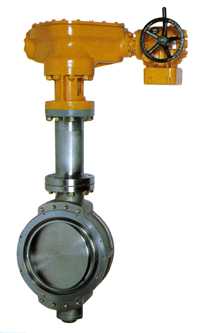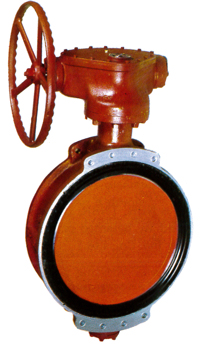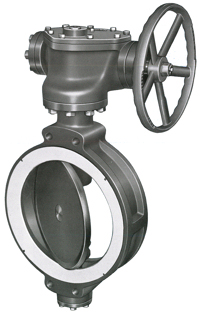
Butterfly valves have a long history, yet they are used more and more in new applications. At present, the demand for butterfly valve is increasing rapidly. The reason lies in it’s simple structure (see figure 1.) and the economic merit of small piping space requirement. The merit of high reliability can be also added, as is indicated in the outstanding manoeuvring and control properties. One of the characteristics of butterfly valves is that the advantage is all the more developed as the valve diameter becomes larger. Nakakita Seisakusho is devoted to the development of the valve and valve system, and Nakakita has already produced and delivered more than 100,000 units of butterfly valves of NS-C series. These NS-C series butterfly valves are enjoying a good reputation among customers as the butterfly valves which overcome the shortcomings of the conventional butterfly valve. Below we introduce the variation of butterfly valves of NS-C series to utilize for adequate applications of which are planned at customers. NS-C series butterfly valves, have been developed with an abundant amount of experience along with a prominent delivery record, are renowned for performance and quality and, we are confident, you will find best suited to serve the marine, as well as overland facilities along with equipment handling a fluid from cryogenic condition up to super heated service. Until now, upwards of over 100.000 units of the NS-C series butterfly valves have been delivered.
Get in touch with us
Features of the NS-C series butterfly valve
- Non-leak type with new mechanism (total closure type).
- Wear and distortion are infinitely small; double eccentric metal seat and valve disc come in contact only when valve is fully closed.
- Maintenance is easy (seat ring exchange is extremely simple).
- Valve manoeuvring force is small.
- By-pass valves for equalizing pressure are never required.
- Selection possibility of driving section (wrench type, handle type, pneumatic type, hydraulic type, electric motor type, etc.).
- Piping occupancy space is small.
- Metal seated butterfly valves are applicable in a wide range of temperatures, and are also available in a fire-proof execution.
- High quality and reliability through mass production techniques.
- Synthetic rubber such as NBR, TNBR, CR and FPM made seat rings are fabricated by patented production system.
Construction of the rubber seated butterfly valve

The valve section consists of the body, disc, seat ring, and stem. The drive lever is connected to the stem at its top with a key. The gear housing is mounted at the upper valve body. Therefore, the driving force transfer results in the revolution of stem (the whole stroke 90º) via the key at the stem top. The stem and valve disc are completely fixed by use of the taper pin. Therefore, the stem revolution means directly the revolution of the valve disc and the valve is opened or shut in this way. At the bottom of the stem, the alignment adjusting screw and washers are provided, and an o-ring for fluid sealing purposes is used at the upper part in order to prevent leakage. In general, cast steel is used for the valve disc and the austenite stainless steel is lined at the outer circumferential sliding section. The reason for this is the improvement of the anti-abrasion properties, corrosion resistance and rust prevention. In the valve seat ring, the rubber lining is applied on the rig shape base material. The valve seat covered with the rubber lining is assembled into the valve body by use of small screws. (It is fixed with the piping.) This rubber lining is manufactured under a strict quality control system. Dimensions, adhesive property, air bubble, and so forth, are particularly checked according to strict procedures. Special synthetic rubber is selected for each specific application purpose. Severe examination is carried out on the resistance to the solvent, friction resistance, weather proof etc. when determining the rubber quality. The shape of the valve disc and valve seat is so designed as to allow for extremely smooth sliding. Leakage is prevented since the contact area between the valve disc and seat is large and the close contact condition and stability are outstanding, while the rubber material durability is excellent.
Construction of the metal seated butterfly valve
The valve body segment consists mainly of valve body, valve disc, valve seat ring and valve stem. The fork lever is connected by a key to the top of the valve stem, and its housing is mounted on the top flange of the valve body. The valve stem is connected firmly with the valve disc by taper pins so as to manoeuvre the valve disc.
The position of the valve disc and the valve seat ring is such that the contacting surfaces are kept apart from each other by slightly eccentrifying the rotating centre of the disc, except when the disc is in a completely closed position.
Stellite is used on the spherical surfaces of the disc and seat ring. The seat ring has a lip in shape and has some elasticity which ensures the complete shut-off of fluids.
Construction of the PTFE seated butterfly valve
 This butterfly valve design is based on a synthetic rubber seated butterfly valve. A wrench type, manual operated valve, with compact construction for low pressure service. The seat ring is made up of synthetic rubber (same as the conventional type), with a specially moulded PTFE (Poly Tetra Fluoride Ethylene) sheet with thickness of 0,5 mm covering on its external surface. Using PTFE, the synthetic rubber is perfectly protected from fluid whilst still allowing for an effective elasticity of the synthetic rubber to ensure a good sealing performance of the seat ring. PTFE has excellent characteristics against solvents and weather.
This butterfly valve design is based on a synthetic rubber seated butterfly valve. A wrench type, manual operated valve, with compact construction for low pressure service. The seat ring is made up of synthetic rubber (same as the conventional type), with a specially moulded PTFE (Poly Tetra Fluoride Ethylene) sheet with thickness of 0,5 mm covering on its external surface. Using PTFE, the synthetic rubber is perfectly protected from fluid whilst still allowing for an effective elasticity of the synthetic rubber to ensure a good sealing performance of the seat ring. PTFE has excellent characteristics against solvents and weather.
Double eccentric construction
The valve disc and the seat ring are moved with each other very smoothly without any strained power by its low friction and double eccentric construction. Double eccentric construction prevents excessive compression on the seat ring by the valve disc partly at the fully opened position. By using this arrangement, these valves can be kept at a fully opened or closed position without damage on the seat ring during long periods of inactivity.